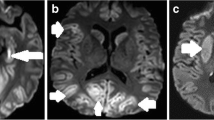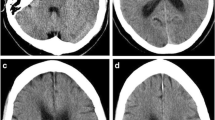Access this chapter
Tax calculation will be finalised at checkout
Purchases are for personal use only
Similar content being viewed by others
Reference
Barzó P, Marmarou A, Fatouros P et al (1996) Magnetic resonance imaging-monitored acute blood-brain barrier changes in experimental traumatic brain injury. J Neurosurg 85: 1113–1121
Bullock R, Statham J, Patterson D, Wyper D, Hadley D, Teasdale E (1990) The time course of vasogenic oedema after focal human head injury: evidence from SPECT mapping of blood brain barrier defects. Acta Neurochir (Wien) 51: 286–288
Ito J, Marmarou A, Barzo P et al (1996) Characterization of edema by diffusion-weighted imaging in experimental traumatic brain injury. J Neurosurg 84: 97–103
Katayama Y, Tsubokawa T, Miyazaki S, Kawamata T, Yoshino A (1990) Oedema fluid formation within contused brain tissue as a cause of medically uncontrollable elevation of intracranial pressure in head trauma patients. Acta Neurochir (Wien) 51: 308–310
Katayama Y, Tsubokawa T, Kinoshita K, Himi K (1992) Intra-parenchymal fluid-blood levels in traumatic intracerebral hematomas. Neuroradiol 34: 381–383
Katayama Y, Mori T, Maeda T et al (1999) Pathogenesis of the mass effect of cerebral contusions: rapid increase in osmolality within the contusion necrosis. Acta Neurochir (Wien) (in press)
Kushi H, Katayama Y, Shibuya T, Tsubokawa T, Kuroha T (1994) Gd-DTPA enhanced magnetic resonance imaging of cerebral contusions. Acta Neurochir (Wien) 60: 472–474
Lindenberg R, Freytag E (1957) Morphology of cortical contusion. Arch Path 63: 23–42
Author information
Authors and Affiliations
Editor information
Editors and Affiliations
Rights and permissions
Copyright information
© 2002 Springer-Verlag
About this paper
Cite this paper
Tsubokawa, T., Katayama, Y., Mori, T., Aoyama, N., Kawamata, T. (2002). Mechanisms of the Mass Effect of Cerebral Contusion: ICP Monitoring and Diffusion MRI Study. In: Czosnyka, M., Pickard, J.D., Kirkpatrick, P.J., Smielewski, P., Hutchinson, P. (eds) Intracranial Pressure and Brain Biochemical Monitoring. Acta Neurochirurgica Supplements, vol 81. Springer, Vienna. https://doi.org/10.1007/978-3-7091-6738-0_72
Download citation
DOI: https://doi.org/10.1007/978-3-7091-6738-0_72
Publisher Name: Springer, Vienna
Print ISBN: 978-3-7091-7397-8
Online ISBN: 978-3-7091-6738-0
eBook Packages: Springer Book Archive




